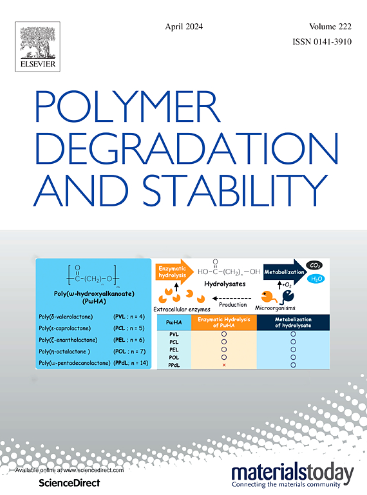A set of intrinsically flame retardant, halogen-free styrenic copolymers: Synthesis, characterization, processing, and properties
IF 6.3
2区 化学
Q1 POLYMER SCIENCE
引用次数: 0
Abstract
Halogen-free, intrinsically flame retardant copolymers with glass transition temperatures in the range of 93 - 97 °C were synthesized from styrene, elemental sulfur, and organophosphorus comonomers in a facile radical bulk polymerization process. The copolymers were characterized using multidetector size exclusion chromatography (SEC), elemental analysis (EA), thin layer chromatography (TLC), UV/Vis spectroscopy, and 1H, 13C, and 31P nuclear magnetic resonance (NMR) spectroscopy. SEC revealed number average molar masses (Mn) ranging from 14 - 18 kg/mol, and weight average molar masses (Mw) from 41 - 62 kg/mol. The phosphorus contents ranged from 0.1 - 0.6 wt.%, while the sulfur contents were 0.4 - 0.7 wt.%, with covalently bound sulfur being predominantly present in the lower molar mass fractions. Structural details of the formed sulfur-containing moieties in the copolymers were elucidated with homonuclear correlation spectroscopy (COSY) and 1H/13C heteronuclear single-quantum correlation spectroscopy (HSQC) techniques, indicating the presence of PS-substituted 1-phenylethyl sulfanyl units with a mono-, di- or trisulfidic arrangement. Thermogravimetric analyses (TGA) showed slightly decreased decomposition onset temperatures for all copolymers compared to that for polystyrene, and no or only minimal formation of residual masses above 500 °C. Selected copolymers were extruded and injection molded on a laboratory scale. UL 94 vertical flame testing demonstrated a good flame retardant performance for most copolymer types, alongside with short after-flaming times and intensive melt dripping. Increased melt flow caused by polymer decomposition, probably initiated by the sulfur moieties in the copolymer structures, and cooling are considered the main condensed-phase flame retardant processes involved. Two copolymers of the set display a UL 94 V-0 classification.
求助全文
约1分钟内获得全文
求助全文
来源期刊

Polymer Degradation and Stability
化学-高分子科学
CiteScore
10.10
自引率
10.20%
发文量
325
审稿时长
23 days
期刊介绍:
Polymer Degradation and Stability deals with the degradation reactions and their control which are a major preoccupation of practitioners of the many and diverse aspects of modern polymer technology.
Deteriorative reactions occur during processing, when polymers are subjected to heat, oxygen and mechanical stress, and during the useful life of the materials when oxygen and sunlight are the most important degradative agencies. In more specialised applications, degradation may be induced by high energy radiation, ozone, atmospheric pollutants, mechanical stress, biological action, hydrolysis and many other influences. The mechanisms of these reactions and stabilisation processes must be understood if the technology and application of polymers are to continue to advance. The reporting of investigations of this kind is therefore a major function of this journal.
However there are also new developments in polymer technology in which degradation processes find positive applications. For example, photodegradable plastics are now available, the recycling of polymeric products will become increasingly important, degradation and combustion studies are involved in the definition of the fire hazards which are associated with polymeric materials and the microelectronics industry is vitally dependent upon polymer degradation in the manufacture of its circuitry. Polymer properties may also be improved by processes like curing and grafting, the chemistry of which can be closely related to that which causes physical deterioration in other circumstances.
 求助内容:
求助内容: 应助结果提醒方式:
应助结果提醒方式:


